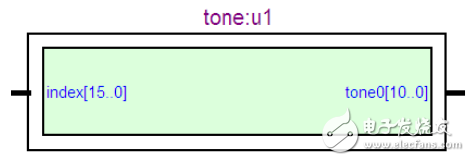

基于vhdl蜂鸣器程序设计详解
编程实验
描述
蜂鸣器是一种一体化结构的电子讯响器,采用直流电压供电,广泛应用于计算机、打印机、复印机、报警器、电子玩具、汽车电子设备、电话机、定时器等电子产品中作发声器件。蜂鸣器主要分为压电式蜂鸣器和电磁式蜂鸣器两种类型。蜂鸣器在威廉希尔官方网站 中用字母“H”或“HA”(旧标准用“FM”、“ZZG”、“LB”、“JD”等)表示。本文为大家介绍基于vhdl蜂鸣器程序设计。
实验步骤

1、设置端口
1)输入端口
CLK:40MHZ系统时钟输入端口。
2)输出端口
device:乐曲的声音输出端口,输出的是对应各音符频率的方波信号。 2、设置模块 1)自动演奏模块
自动演奏模块可以自动播放电子琴内置乐曲,按节拍读取内置乐谱。将键盘输入的音符信号输出。因此,本模块是向Tone模块提供音符信息。
首先,对40MHz系统时钟进行10M的分频,得到4Hz的信号,这样一秒中就可以按照四拍进行。然后依照此频率进行地址累计。

音频发生器模块
根据自动演奏模块的信号输出,不同的信号被翻译为不同的频率。

蜂鸣器驱动模块
根据音频发生器发出音频的不同,蜂鸣器得到的驱动也不同。首先,对系统时钟进行40分频,再对1mhz的脉冲再次分频,得到所需要的音符频率,然后再进行2分频。

实验代码
library ieee;
use ieee.std_logic_1164.all;
use ieee.std_logic_arith.all;
use ieee.std_logic_unsigned.all;
entity tone is port( index: in std_logic_vector(15 downto 0); --音符输入信号
tone0: out integer range 0 to 2047 --音符的分频系数 );
end tone;
architecture behavioral of tone is
begin
search :process(index) --此进程完成音符到音符的分频系数译码,音符的显示,高低音阶
begin
case index is
when “0000000000000001” => tone0<=1433;
when “0000000000000010” => tone0<=1277;
when “0000000000000100” => tone0<=1138;
when “0000000000001000” => tone0<=1074;
when “0000000000010000” => tone0<=960;
when “0000000000100000” => tone0<=853;
when “0000000001000000” => tone0<=759;
when “0000000010000000” => tone0<=716;
when “0000000100000000” => tone0<=358;
when “0000001000000000” => tone0<=319;
when “0000010000000000” => tone0<=284;
when “0000100000000000” => tone0<=268;
when “0001000000000000” => tone0<=239;
when “0010000000000000” => tone0<=213;
when “0100000000000000” => tone0<=190;
when “1000000000000000” => tone0<=638;
when others => tone0<=0;
end case;
end process;
end behavioral;
library ieee;
use ieee.std_logic_1164.all;
use ieee.std_logic_arith.all;
use ieee.std_logic_unsigned.all;
entity speaker is port( clk1: in std_logic; --系统时钟12mhz
tone1: in integer range 0 to 2047; --音符分频系数
spks: out std_logic --驱动扬声器的音频信号 );
end speaker;
architecture behavioral of speaker is
signal preclk, fullspks:std_logic;
begin
p1:process(clk1)--此进程对系统时钟进行16分频
variable count: integer range 0 to 16;
begin
if clk1‘event and clk1=’1‘ then count:=count+1;
if count=8 then
preclk<=‘1’;
elsif count=16 then preclk<=‘0’;
count:=0;
end if;
end if;
end process p1;
p2:process(preclk,tone1)--对0.75mhz的脉冲再次分频,得到所需要的音符频率
variable count11:integer range 0 to 2047;
begin
if preclk‘event and preclk=’1‘ then
if count11
count11:=count11+1;
fullspks<=’1‘;
else
count11:=0;
fullspks<=’0‘;
end if;
end if;
end process p2;
p3:process(fullspks)--此进程对fullspks进行2分频
variable count2: std_logic:=’0‘;
begin
if fullspks’event and fullspks=‘1’ then
count2:=not count2;
if count2=‘1’ then
spks<=‘1’;
else spks<=‘0’;
end if;
end if;
end process p3;
end behavioral;
library ieee;
use ieee.std_logic_1164.all;
use ieee.std_logic_arith.all;
use ieee.std_logic_unsigned.all;
entity laohu is port( clk: in std_logic;--系统时钟;键盘输入/自动演奏
tone_key_0: buffer std_logic_vector(15 downto 0)--音符信号输出
);
end laohu;
architecture behavioral of laohu is
signal count0:integer range 0 to 31;--change
signal clk2:std_logic;
begin p1:process(clk) --对12mhz系统时钟进行3m的分频,得到4hz的信号clk2
variable count:integer range 0 to 3000000;
begin if clk‘event and clk=’1‘ then
count:=count+1;
if count=1500000 then
clk2<=’1‘;
elsif count=3000000 then
clk2<=’0‘;
count:=0;
end if;
end if;
end process p1;
p2:process(clk2)--此进程完成自动演奏部分乐曲的地址累加
begin if clk2’event and clk2=‘1’ then
if count0=29 then
count0<=0;
else count0<=count0+1;
end if;
end if;
end process p2;
p3:process(count0,tone_key_0)
begin
case count0 is--此case语句:存储自动演奏部分的乐曲
when 0 => tone_key_0<=b“00000001_00000000”; --1
when 1 => tone_key_0<=b“00000010_00000000”; --2
when 2 => tone_key_0<=b“00000100_00000000”; --3
when 3 => tone_key_0<=b“00000001_00000000”; --1
when 4 => tone_key_0<=b“00000001_00000000”; --1
when 5 => tone_key_0<=b“00000010_00000000”; --2
when 6 => tone_key_0<=b“00000100_00000000”; --3
when 7 => tone_key_0<=b“00000001_00000000”; --1
when 8 => tone_key_0<=b“00000100_00000000”; --3
when 9 => tone_key_0<=b“00001000_00000000”; --4
when 10 => tone_key_0<=b“00010000_00000000”; --5
when 11 => tone_key_0<=b“00000100_00000000”; --3
when 12 => tone_key_0<=b“00001000_00000000”; --4
when 13 => tone_key_0<=b“00010000_00000000”; --5
when 14 => tone_key_0<=b“00010000_00000000”; --5
when 15 => tone_key_0<=b“00100000_00000000”; --6
when 16 => tone_key_0<=b“00010000_00000000”; --5
when 17 => tone_key_0<=b“00001000_00000000”; --4
when 18 => tone_key_0<=b“00000100_00000000”; --3
when 19 => tone_key_0<=b“00000001_00000000”; --1
when 20 => tone_key_0<=b“00010000_00000000”; --5
when 21 => tone_key_0<=b“00100000_00000000”; --6
when 22 => tone_key_0<=b“00010000_00000000”; --5
when 23 => tone_key_0<=b“00001000_00000000”; --4
when 24 => tone_key_0<=b“00000100_00000000”; --3
when 25 => tone_key_0<=b“00000001_00000000”; --1
when 26 => tone_key_0<=b“00000100_00000000”; --3
when 27 => tone_key_0<=b“00000000_00100000”; --di6
when 28 => tone_key_0<=b“00000001_00000000”; --1
when others => null;
end case;
end process p3;
end behavioral;
library ieee;
use ieee.std_logic_1164.all;
use ieee.std_logic_arith.all;
use ieee.std_logic_unsigned.all;
entity beep0 is
port( clk:in std_logic; device:out std_logic );
end beep0;
architecture behavioral of beep0 is
component laohu is port( clk: in std_logic;--系统时钟;键盘输入/自动演奏
tone_key_0: out std_logic_vector(15 downto 0)--音符信号输出 );
end component;
component tone is
port( index: in std_logic_vector(15 downto 0);--音符输入信号
tone0: out integer range 0 to 2047--音符的分频系数 );
end component;
component speaker is
port(
clk1: in std_logic;--系统时钟12mhz
tone1: in integer range 0 to 2047; --音符分频系数
spks: out std_logic--驱动扬声器的音频信号 );
end component;
signal mid:std_logic_vector(15 downto 0);
signal tones:integer;
begin
u0:laohu port map(clk,mid);
u1:tone port map(mid,tones);
u2:speaker port map(clk,tones,device);
end behavioral;
-
VHDL程序设计教程 (pdf 经典电子书)2009-10-09 0
-
VHDL语言100例详解2012-08-20 0
-
FPGA的VHDL程序基本结构是怎样的?FPGA的VHDL程序设计单元关系图2018-09-07 0
-
VHDL 语言程序的元素2009-09-28 354
-
出租车计价器VHDL程序2008-06-27 1930
-
VHDL设计中信号与变量问题的研究2010-04-12 1346
-
VHDL语言程序设计及应用(第二版)_姜立东2015-07-15 687
-
单片机驱动蜂鸣器原理与程序设计2015-12-23 869
-
VHDL应用工程2016-02-17 502
-
ARM_C语言程序设计详解2017-10-27 886
-
vhdl数码管动态扫描程序设计(四种设计方案)2018-01-29 18096
-
使用VHDL硬件描述语言实现基带码发生器的程序设计与仿真2021-01-20 770
-
STM32 IAP升级程序设计详解-IAR环境2021-12-03 668
-
STC学习:蜂鸣器2021-12-23 873
-
multisim蜂鸣器驱动程序详解2024-08-09 872
全部0条评论

快来发表一下你的评论吧 !

